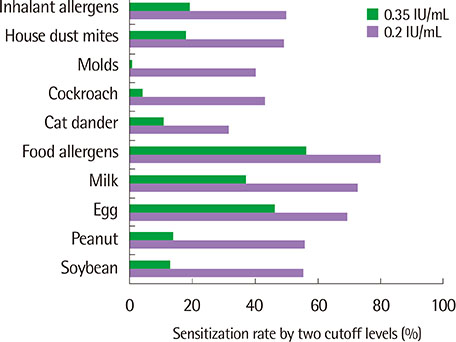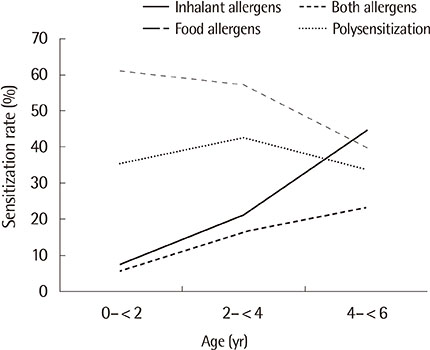Sensitization patterns to common allergens in Korean children younger than 6 years of age presenting with typical symptoms or signs of allergic diseases: a single center study
- Affiliations
-
- 1Department of Pediatrics, Myongji Hospital, Goyang, Korea.
- 2Department of Pediatrics, CHA University School of Medicine, Pocheon, Korea. epirubicin13@gmail.com
- 3Department of Pediatrics, Hallym University Kangdong Sacred Heart Hospital, Hallym University College of Medicine, Seoul, Korea.
- 4Department of Pediatrics, Bundang Jaesaeng Hospital, Seongnam, Korea.
- 5Department of Pediatrics, Kyung Hee University Hospital at Gangdong, Kyung Hee University School of Medicine, Seoul, Korea.
- 6Department of Pediatrics, Seoul Medical Center, Seoul, Korea.
- 7Department of Pediatrics, The Catholic University of Korea School of Medicine, Seoul, Korea.
- KMID: 2262395
- DOI: http://doi.org/10.4168/aard.2014.2.4.272
Abstract
- PURPOSE
Population studies have reported that sensitization to inhalant allergens is rare in young children; however, most subjects in those studies had little or no symptoms or signs highly suggestive of allergic diseases. The aim of the present study was to assess the prevalence of sensitization to inhalant allergens in young children with symptoms and/or signs of allergic disease.
METHODS
We analyzed the results of all specific IgE tests performed at our hospital laboratory in children younger than 6 years presenting with symptoms and/or signs highly suggestive of allergic diseases between 2008 and 2013. Specific IgE tests for Dermatophagoides pteronyssinus, Dermatophagoides farinae, Alternaria alternata, German cockroach, cat dander, egg white or egg yolk, milk, peanut, and soybean were performed on 295 children; a specific IgE concentration > or =0.35 or > or =0.2 IU/mL was considered positive. We also compared allergen sensitization rates using the two cutoff values.
RESULTS
One hundred eighty-one children (61.4%) were positive to at least 1 allergen tested and 53 children (18.9%) were positive to at least 1 inhalant allergen when a specific IgE concentration > or =0.35 IU/mL was considered positive. The children were more likely to have asthma or allergic rhinitis when they were sensitized to any inhalant allergen, particularly house dust mites. The prevalence of sensitization to inhalant allergens increased with age (P<0.001). There was no significant difference in the prevalence of polysensitization among different age groups, but sensitization to both inhalant and food allergens significantly increased with age.
CONCLUSION
Our results suggest that specific IgE tests to common inhalant allergens, particularly the house dust mites, may be considered when performing blood screening tests for young children presenting with symptoms and/or signs of allergic diseases.
Keyword
MeSH Terms
Figure
Cited by 4 articles
-
Research on pediatric allergic rhinitis in Korea
Kyung Suk Lee, Yeong Ho Rha
Allergy Asthma Respir Dis. 2018;6(Suppl 1):S58-S65. doi: 10.4168/aard.2018.6.S1.S58.Clinical characteristics of allergic rhinitis and nonallergic rhinitis in Korean children
Na Hae Won, Sang Hyun Park, So Hyun Ahn, Chae Bong Kim, Jung Hyun Kwon, Won Hee Seo, Dae Jin Song, Young Yoo
Allergy Asthma Respir Dis. 2020;8(1):20-29. doi: 10.4168/aard.2020.8.1.20.Allergen sensitization and vitamin D status in young Korean children with urticaria
Jeong Bong Lee, Shin Hae Lee, Man Yong Han, Jung Won Yoon
Allergy Asthma Respir Dis. 2017;5(3):153-158. doi: 10.4168/aard.2017.5.3.153.Proper allergen selection for serum specific IgE test in children
Yong Ju Lee, Hyeon-Jong Yang, Jong-Seo Yoon, Man-Yong Han, Chang Keun Kim, Jin Tack Kim
Allergy Asthma Respir Dis. 2018;6(5):237-240. doi: 10.4168/aard.2018.6.5.237.
Reference
-
1. Illi S, von Mutius E, Lau S, Niggemann B, Gruber C, Wahn U, et al. Perennial allergen sensitisation early in life and chronic asthma in children: a birth cohort study. Lancet. 2006; 368:763–770.
Article2. Hoffmann-Petersen B, Host A, Larsen KT, Bergstein KR, Thomsen ML, Braendholt V, et al. Prevalence of IgE sensitization in Danish children with suspected asthma. Pediatr Allergy Immunol. 2013; 24:727–733.
Article3. Porsbjerg C, von Linstow ML, Ulrik CS, Nepper-Christensen S, Backer V. Risk factors for onset of asthma: a 12-year prospective follow-up study. Chest. 2006; 129:309–316.4. Arshad SH, Tariq SM, Matthews S, Hakim E. Sensitization to common allergens and its association with allergic disorders at age 4 years: a whole population birth cohort study. Pediatrics. 2001; 108:E33.
Article5. Govaere E, Van Gysel D, Massa G, Verhamme KM, Doli E, De Baets F. The influence of age and gender on sensitization to aero-allergens. Pediatr Allergy Immunol. 2007; 18:671–678.
Article6. Baatenburg de Jong A, Dikkeschei LD, Brand PL. High prevalence of sensitization to aeroallergens in children 4 yrs of age or younger with symptoms of allergic disease. Pediatr Allergy Immunol. 2009; 20:735–740.
Article7. Kulig M, Bergmann R, Klettke U, Wahn V, Tacke U, Wahn U. Natural course of sensitization to food and inhalant allergens during the first 6 years of life. J Allergy Clin Immunol. 1999; 103:1173–1179.
Article8. Roberts G, Peckitt C, Northstone K, Strachan D, Lack G, Henderson J, et al. Relationship between aeroallergen and food allergen sensitization in childhood. Clin Exp Allergy. 2005; 35:933–940.
Article9. Douwes J, van Strien R, Doekes G, Smit J, Kerkhof M, Gerritsen J, et al. Does early indoor microbial exposure reduce the risk of asthma? The Prevention and Incidence of Asthma and Mite Allergy birth cohort study. J Allergy Clin Immunol. 2006; 117:1067–1073.
Article10. Kjaer HF, Eller E, Andersen KE, Host A, Bindslev-Jensen C. The association between early sensitization patterns and subsequent allergic disease. The DARC birth cohort study. Pediatr Allergy Immunol. 2009; 20:726–734.
Article11. Kim EJ, Kwon JW, Lim YM, Yoon D, Seo JH, Chang WS, et al. Assessment of Total/Specific IgE Levels Against 7 Inhalant Allergens in Children Aged 3 to 6 Years in Seoul, Korea. Allergy Asthma Immunol Res. 2013; 5:162–169.
Article12. Sicherer SH, Sampson HA. Food allergy. J Allergy Clin Immunol. 2010; 125:2 Suppl 2. S116–S125.
Article13. Brozek JL, Bousquet J, Baena-Cagnani CE, Bonini S, Canonica GW, Casale TB, et al. Allergic Rhinitis and its Impact on Asthma (ARIA) guidelines: 2010 revision. J Allergy Clin Immunol. 2010; 126:466–476.
Article14. Bateman ED, Hurd SS, Barnes PJ, Bousquet J, Drazen JM, FitzGerald M, et al. Global strategy for asthma management and prevention: GINA executive summary. Eur Respir J. 2008; 31:143–178.
Article15. Brenninkmeijer EE, Schram ME, Leeflang MM, Bos JD, Spuls PI. Diagnostic criteria for atopic dermatitis: a systematic review. Br J Dermatol. 2008; 158:754–765.
Article16. Zuberbier T, Asero R, Bindslev-Jensen C, Walter Canonica G, Church MK, Gimenez-Arnau A, et al. EAACI/GA(2)LEN/EDF/WAO guideline: definition, classification and diagnosis of urticaria. Allergy. 2009; 64:1417–1426.
Article17. Depner M, Ege MJ, Genuneit J, Pekkanen J, Roponen M, Hirvonen MR, et al. Atopic sensitization in the first year of life. J Allergy Clin Immunol. 2013; 131:781–788.
Article18. Kim J, Hahm MI, Lee SY, Kim WK, Chae Y, Park YM, et al. Sensitization to aeroallergens in Korean children: a population-based study in 2010. J Korean Med Sci. 2011; 26:1165–1172.
Article19. Park SH, Lim DH, Son BK, Kim JH, Song YE, Oh IB, et al. Sensitization rates of airborne pollen and mold in children. Korean J Pediatr. 2012; 55:322–329.
Article20. Platts-Mills TA, Vervloet D, Thomas WR, Aalberse RC, Chapman MD. Indoor allergens and asthma: report of the Third International Workshop. J Allergy Clin Immunol. 1997; 100(6 Pt 1):S2–S24.21. Shin JW, Sue JH, Song TW, Kim KW, Kim ES, Sohn MH, et al. Atopy and house dust mite sensitization as risk factors for asthma in children. Yonsei Med J. 2005; 46:629–634.
Article22. Verhoeff AP, Van Strien RT, Van Wijnen JH, Brunekreef B. House dust mite allergen (Der p I) and respiratory symptoms in children: a case-control study. Clin Exp Allergy. 1994; 24:1061–1069.
Article23. Fasce L, Tosca MA, Baroffio M, Olcese R, Ciprandi G. Atopy in wheezing infants always starts with monosensitization. Allergy Asthma Proc. 2007; 28:449–453.
Article24. Frew AJ. 25. Immunotherapy of allergic disease. J Allergy Clin Immunol. 2003; 111:2 Suppl. S712–S719.
Article
- Full Text Links
- Actions
-
Cited
- CITED
-
- Close
- Share
- Similar articles
-
- Allergen sensitization trajectories in children with respiratory and allergic diseases
- Change of Inhalant Allergen Sensitization in Children with Allergic Respiratory Diseases during Recent 10 Years
- Changes in allergen sensitization in children with allergic diseases in the 1980 to 2019
- Comparison of inhalant allergen sensitization between children, adolescents, and adults with asthma and allergic rhinitis
- Recent changing pattern of aeroallergen sensitization in children with allergic diseases: A single center study



